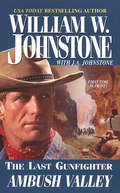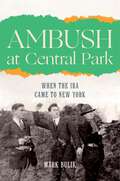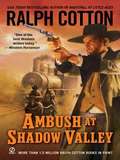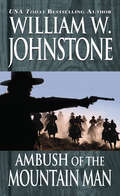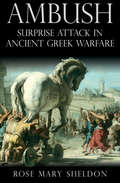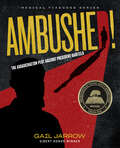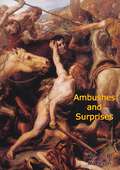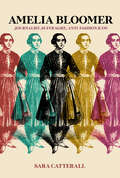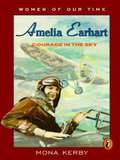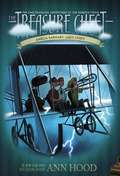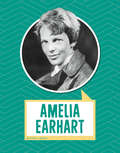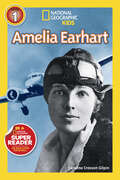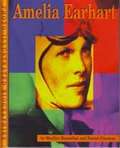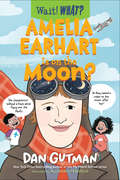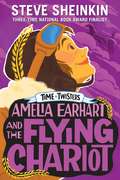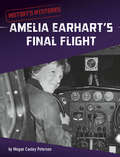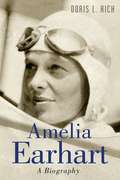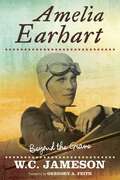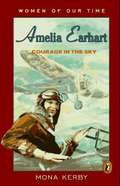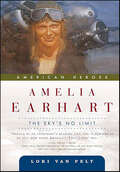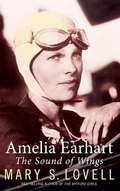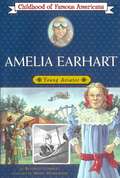- Table View
- List View
Ambush Valley: Ambush Valley (The Last Gunfighter #17)
by William W. Johnstone J.A. JohnstoneUSA Today bestselling author: Frank Morgan is in Yuma Prison—and on a mission . . .Yuma Prison is a fetid hellhole filled with the dregs of humanity—killers, thieves, and backstabbers who'd kill over a scrap of meat. Now it's home to Frank Morgan, who's posing as an inmate. A ruthless outlaw named Cicero McCoy has buried a fortune in stolen bank money in a harsh, desolate little piece of hell known as Ambush Valley. To get Cicero to lead him to the loot, Frank has become Cicero's new best friend behind bars—and co-plotter of a daring breakout. Soon, the last gunfighter and a stone-cold killer are blazing away at enemies on both sides of the law. Until the time comes for Frank Morgan to make a fatal choice—and for one of them to die . . .
Ambush at Central Park: When the IRA Came to New York
by Mark BulikA compelling, action-packed account of the only officially sanctioned I.R.A attack ever conducted on American soil.In 1922, three of the Irish Republican Army’s top gunmen arrived in New York City seeking vengeance. Their target: “Cruxy” O’Connor, a young Irishman who kept switching sides as revolution swept his country in the wake of World War I. Cruxy’s last betrayal dealt a stunning blow to Ireland’s struggle for independence: Six of his IRA comrades were killed when he told police the location of their safe house outside Cork. A year later, the IRA gunned him down in a hail of bullets before a crowd of horrified New Yorkers at the corner of 84th Street and Central Park West.Based primarily on first-hand accounts, most of them never before published, Ambush at Central Park is a cinematic exploration of the enigma of “Cruxy” O’Connor: Was he really a decorated war hero who became a spy for Britain? When he defected to the IRA, did his machine gun really jam in a crucial attack? When captured, did he give up his IRA comrades only under torture? Was he a British spy all along? Or was he pursuing a decades-old blood feud between his family and that of one of his comrades?A longtime editor at The New York Times, author Mark Bulik delved through Irish government archives, newspaper accounts, census data, and unpublished material from the families of the main actors. Together they add to the sensational story of a rebel ambush, a deadly police raid, a dinner laced with poison, a daring prison break, a boatload of tommy guns on the Hoboken waterfront, an unlikely pair of spies who fall in love, and an audacious assassination plot against the British cabinet.Gravely wounded and near death, Cruxy refused to cooperate with the detectives investigating the case. And so, the spy who stopped spying and the gunman who stopped shooting became the informer who wouldn’t inform, even at death’s door. Here is a forgotten chapter of Irish and New York history: the story of the only officially authorized IRA attack on American soil.
Ambush at Shadow Valley
by Ralph CottonArizona Ranger Sam Burrack is on the trail of a gang of Yuma jailbreakers led by the blood-thirsty Suela Soto, and he's leaving a trail of death and destruction. The pursuit will bring Sam up against one of the most infamous criminal gangs ever to pull a heist in the West-the Hole in the Wall Gang. . .
Ambush of the Mountain Man (Mountain Man #31)
by William W. JohnstoneTHE GREATEST WESTERN WRITER OF THE 21ST CENTURYSmoke Jensen never wanted to kill, but fate had other plans, and the Mountain Man has left plenty of blood, tears and fury in his wake. Angus MacDougal, the father of one of Smoke's victims, wants revenge. Riding up to Big Rock, Colorado, MacDougal has decided that killing Smoke won't be enough. He intends to bring him back to Pueblo and hang him before a crowd. It's a bloodthirsty plan that might have worked, except for a beautiful young woman, and the small knife she slips into Smoke's hand.Suddenly Smoke is on the run in the Colorado wilderness with no gun, no supplies, and twenty armed men in pursuit. Once, a man named Preacher taught Smoke how to survive in this wilderness. Now, as a brutal winter bears down, the Mountain Man will use those lessons well—not only to fight his way out alive, but also for vengeance of his own. . .
Ambush: Surprise Attack in Ancient Greek Warfare
by Rose Mary SheldonThere are two images of warfare that dominate Greek history. The better known is that of Achilles, the Homeric hero skilled in face-to-face combat to the death. He is a warrior who is outraged by deception on the battlefield. The alternative model, equally Greek and also taken from Homeric epic, is Odysseus, the man of twists and turns of The Odyssey. To him, winning by stealth, surprise or deceit was acceptable.Greek warfare actually consists of many varieties of fighting. It is common for popular writers to assume that the hoplite phalanx was the only mode of warfare used by the Greeks. The fact is, however, that the use of spies, intelligence gathering, ambush, and surprise attacks at dawn or at night were also a part of Greek warfare, and while not the supreme method of defeating an enemy, such tactics always found their place in warfare when the opportunity or the correct terrain or opportunity presented itself.Ambush will dispel both the modern and ancient prejudices against irregular warfare and provides a fresh look at the tactics of the ancient Greeks.
Ambushed!: The Assassination Plot Against President Garfield (Medical Fiascoes)
by Gail JarrowThis thrilling title for young readers blends science, history, and medical mysteries to tell the story of the assassination and ultimately horrible death of President James Garfield.James Abram Garfield, the 20th President of the United States, was assassinated when he was shot by Charles Guiteau in July 1881, less than four months after he was elected president. But Garfield didn't actually die until 80 days later. In this page-turner, award-winning author Gail Jarrow delves into the fascinating story of the relationship between Garfield and Guiteau, and relates the gruesome details of Garfield's slow and agonizing death. She reveals medical mistakes made in the aftermath of Garfield's assassination, including the faulty diagnoses and outdated treatments that led to the president's demise. This gripping blend of science, history, and mystery — the latest title in the Medical Fiascoes series — is nonfiction for kids at its best: exciting and relevant and packed with plenty of villains and horrifying facts.
Ambushes and Surprises
by Col. G. B. MallesonAmbushes and surprise attacks are tactics as old as warfare itself. This instructive and interesting book, written by a distinguished Victorian soldier and military historian, describes and analyses some of history’s most famous military ambushes—including Hannibal’s waylaying of the Romans on the shores of Lake Trasimene; the other great disaster to Roman arms when the Legions were lured to their doom by the Teutonic tribes of Germanicus in the Teutoburg Forest; from the Age of Charlemagne Malleson tells the story of Roland and Oliver’s doomed stand against the Moors at Roncesvalles in the Pyrenees. Other surprises and ambushes recounted in the book include Marshal Massena’s campaign of 1799 around the St Gothard Pass in the Swiss Alps, and France’s successful ambush of Braddock’s British force in the North American wilderness at Fort Duquesne. Each account is illustrated by a map, making this a most illuminating as well as an highly entertaining, read.-Print ed.
Ame Apenas a Mim
by Amanda MarielNascida nobre, criada em meio às travessuras, Lady Narissa se move com facilidade entre a elite de Londres e seus fantoches. Sem aceitar bem o seu papel como filha de um conde, ela abre uma casa de apostas apenas para mulheres, tendo como público-alvo as damas da ton. Ela está determinada a proteger o seu legado a todo custo. Seth Blakley, o Duque de Blackmore, está às voltas com a irmã espevitada. Seu único desejo é vê-la bem casada antes que ela se veja completamente arruinada. Ele nunca poderia ter imaginado no que estava se metendo quando a seguiu até a casa de apostas de Lady Narissa. Seth é atraído para Lady Narissa e se vê determinado a aprender mais sobre a bela moça teimosa e pouco convencional. Não importa que tudo o que ela deseja seja que ele suma e que esqueça que o seu clube existe. A paixão os aproxima quando eles descobrem que o amor é mais importante que obrigações e lealdades que ameaçam separá-los.
Amelia Bloomer: Journalist, Suffragist, Anti-Fashion Icon
by Sara CatterallA fascinating look at an underappreciated woman in American history whose newspaper fostered a national conversation on women&’s issues. Those who recognize the name Amelia Bloomer usually do so because of bloomers, the clothing item named after her. While she was a rational dress advocate for a time—calling on women to abandon rigid corsets and heavy petticoats and opt for long trousers, shorter skirts, and sensible boots—it was &“but an incident&” in the larger story of her life and impact. Bloomer edited and published The Lily, the first newspaper for and by women. Founded to promote temperance, it soon broadened to include some of the most important issues to women in that day, including the right to vote, and included contributions from thinkers like Elizabeth Cady Stanton. The groundbreaking paper brought the conversation from Seneca Falls right to the doorsteps of women across the expanding nation. Guided by a rigid sense of morality and a Puritan work ethic, Bloomer remained open-minded to new ideas. She refused to be swayed by social norms and wrote cutting responses to those who tried to intimidate or shame her and her friends, a group that included Stanton and Susan B. Anthony. This deeply researched biography by Sara Catterall follows the many chapters of her life: her humble upbringing in upstate New York, her role in the temperance movement (and its true legacy as a wellspring of the women&’s rights movement), her years at The Lily, her groundbreaking position as deputy postmaster in Seneca falls, her troubled health, and her eventual move to Council Bluffs, Iowa, where she continued to move the needle on women&’s suffrage in the more flexible new governments of the West.
Amelia Earhart
by Jan ParrSixty years after Amelia Earhart's disappearance over the Atlantic, people are still arguing over her fate. This book presents her life from tomboy to headstrong young woman to polished celebrity and explores the impact of her husband, George Putnam, on her life and career It also examines Amelia's impact on aviation and feminism.
Amelia Earhart
by Mona KerbyFollows the life of the pilot who was the first woman to cross the Atlantic by herself in a plane.
Amelia Earhart #8
by Ann Hood Denis ZilberAnn Hood's "delightful" (NYT) historical series continues with one of America's great female heroes! Great-Uncle Thorne sends Maisie, Felix, and the Ziff twins on a dangerous trip back in time through The Treasure Chest and into the Congo to find Amy Pickworth, Thorne's missing aunt. When Maisie and Felix get separated from the twins, they use the magic of The Treasure Chest and find themselves in early twentieth-century Kansas with a young girl named Amelia Earhart. Every Treasure Chest book features a biography of the featured historical figure along with Ann's Favorite Facts from her research!
Amelia Earhart (Biographies)
by Erika L. ShoresHow much do you know about Amelia Earhart? Find out the facts you need to know about this female aviator. You'll learn about the early life, challenges, and major accomplishments of this important American.
Amelia Earhart (National Geographic Kids Readers)
by Caroline Crosson GilpinAmelia Earhart is one of the first of many National Geographic Readers that highlight important historical figures. This Level 1 Reader brings an understanding of Amelia Earhart's historical significance to a whole new audience. Young readers will learn about the fascinating life and legacy of this pioneering pilot and adventurer, whose disappearance over the Pacific in 1937 has intrigued audiences for decades (Level 1).
Amelia Earhart (Photo-Illustrated Biographies)
by Daniel Freeman Marilyn RosenthalA biography of the aviator and women's rights advocate Amelia Earhart, the first woman pilot to fly an airplane alone across the United States, and the Atlantic and Pacific Oceans.
Amelia Earhart Is on the Moon? (Wait! What? #0)
by Dan GutmanFrom the best-selling author of My Weird School: a new entry in the hilarious biography series that casts fresh light on high-interest historic figures. Did you know that Amelia Earhart loved heights so much she built a roller coaster in her backyard? Or that she used to race worms with her sister? Bet you didn’t know that she took photographs of garbage cans to pay for flying lessons! Siblings Paige and Turner do—and they’ve collected some of the most unusual and surprising facts about the legendary pilot, from her childhood in the rural Midwest and the spark of her passion for flying to her record-smashing flights and her infamous disappearance over the Pacific Ocean. Narrated by the two spirited siblings and animated by Allison Steinfeld’s upbeat illustrations, Amelia Earhart Is on the Moon? is an authoritative, accessible, and one-of-a-kind biography infused with Dan Gutman’s signature zany sense of humor.
Amelia Earhart and the Flying Chariot (Time Twisters)
by Steve Sheinkin“A historical home run!” —Dav Pilkey, bestselling author of Captain UnderpantsTwo kids must un-twist history after Amelia Earhart changes course in this hilarious Time Twisters chapter book by award-winning author Steve Sheinkin.WARNING: DO NOT BELIEVE THE STORY YOU’RE ABOUT TO READ.Well, you can believe some of it. There is some real history. But also hijinks. Time travel. And famous figures setting off on adventures that definitely never happened—till now. Time is getting twisted, and it’s up to two kids to straighten things out.Siblings Abby and Doc have been racing through time to fix history after Abraham Lincoln, Abigail Adams, and Neil Armstrong started popping up in the wrong places, at the wrong times. When Amelia Earhart accidentally lands her plane in Ancient Greece, Abby and Doc partner with Kyniska, the first woman to win the Olympics, to get Amelia back on track to finish her first solo flight across the Atlantic. Steve Sheinkin combines history, hilarity, and surprising twists in Amelia Earhart and the Flying Chariot. The Time Twisters series is a surefire hit with history buffs and reluctant readers alike!
Amelia Earhart's Final Flight (History's Mysteries)
by Megan Cooley PetersonOn June 1, 1937, famous pilot Amelia Earhart and her navigator, Fred Noonan, took off in their small plane. Earhart’s goal was to make a record-breaking flight around the world. On the last part of the flight, they approached Howland Island to refuel. Before they could land, radio communication from Earhart stopped, and the plane disappeared. Search efforts turned up few clues. What happened to Earhart and Noonan? Explore the theories and learn why their disappearance has become one of history’s greatest mysteries.
Amelia Earhart: A Biography
by Doris L. RichShe died mysteriously before she was forty. Yet in the last decade of her life Amelia Earhart soared from obscurity to fame as the best-known female aviator in the world. She set record after record--among them, the first trans-Atlantic solo flight by a woman, a flight that launched Earhart on a double career as a fighter for women's rights and a tireless crusader for commercial air travel. Doris L. Rich's exhaustively researched biography downplays the "What Happened to Amelia Earhart?" myth by disclosing who Amelia Earhart really was: a woman of three centuries, born in the nineteenth, pioneering in the twentieth, and advocating ideals and dreams relevant to the twenty-first.
Amelia Earhart: Beyond the Grave (Beyond the Grave)
by W.C. JamesonThis well-researched book is a biography of the life—and disappearance—of Amelia Earhart, the pioneering aviator who was the first woman to fly solo over the Atlantic in 1928. But did Amelia&’s plane really crash and sink in 1937, or was her fate entirely different?
Amelia Earhart: Courage in the Sky (Women of Our Time)
by Mona KerbyAs a child, Amelia Earhart wondered why there were no heroines in her favorite adventure stories. She resolved to change that when she grew up. And so she did, becoming one of the pioneers of aviation. Not only was Amelia the first woman in the world to fly across the Atlantic Ocean, she was the first person to cross it twice. Her life became a great adventure story--and a mystery, too. In 1937, on an around-the-world flight, Amelia disappeared. Today, Amelia's courage and spirit remain an inspiration to everyone who flies or dreams of adventure. This unique series about the lives of twentieth- century women "answers the constant need for more biographies of completeness and quality." -- American Bookseller "Pick of the Lists".
Amelia Earhart: The Sky's No Limit (American Heroes)
by Lori Van PeltA exciting new biography of America's first lady of flight. As a tomboy growing up in Kansas, Amelia Earhart delighted in trying new and risky things, once even building a roller-coaster in her grandparents' backyard. In her 20s she fell in love with flight while watching an aerobatics exhibition and grew even more enthralled when she took her first airplane ride.At age 24 she earned her pilot's wings and 1928 took part in the transatlantic "Friendship" flight. Her willowy build, wholesome smile, and tousled blonde hair invited comparison to the celebrated pilot Charles Lindbergh, and "Lady Lindy" charmed the public with her unassuming manner.Lori Van Pelt's Amelia Earhart: The Sky's No Limit takes readers through Earhart's career triumphs and tragedies. It explorers not only her accomplishments in the field of flight, but also her struggles in the male-dominated world of aviation. Named to the New York Public Library's Best Books for the Teen Age 2006At the Publisher's request, this title is being sold without Digital Rights Management Software (DRM) applied.
Amelia Earhart: The Sound of Wings
by Mary S. LovellWhen she disappeared in 1937 over a shark-infested sea, Amelia Earhart had lived up to her wish - internationally famous, a daring and pioneering aviator, and ambassador extraordinary for the United States. Married to a man with a genius for publicity, her life was crowded, demanding and adventurous. Mary S. Lovell's superb biography examines a legend to reveal the pressures and influences that drove Amelia, and shows how her life, career and manner of death foreshadowed the tragedies and excesses of a media-dominated age.
Amelia Earhart: The Turbulent Life of an American Icon
by Kathleen C. WintersWhen Amelia Earhart disappeared over the Pacific in 1937, she was at the height of her fame. Fascination with Earhart remains just as strong today, as her mysterious disappearance continues to inspire speculation. In this nuanced and often surprising biography, acclaimed aviation historian Kathleen C. Winters moves beyond the caricature of the spunky, precocious pilot to offer a more complex portrait. Drawing on a wealth of contemporary accounts, airline records, and other original research, this book reveals a flawed heroine who was frequently reckless and lacked basic navigation skills, but who was also a canny manipulator of mass media. Winters details how Earhart and her husband, publisher George Putnam, worked to establish her as an international icon, even as other spectacular pilots went unnoticed. Sympathetic yet unsentimental, this biography helps us to see Amelia Earhart with fresh eyes.
Amelia Earhart: Young Aviator (Childhood of Famous Americans Series)
by Beatrice GormleyWhat was Amelia Earhart like as a child and teenager? A fictionalized biography of the famous aviatrix.
